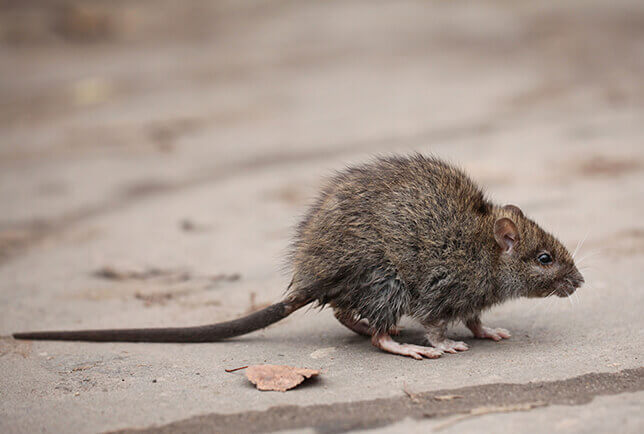What Do Roof Rats Look Like?

Although they’re also known as black rats, roof rats can have fur in any shade of black, brown, or gray with a light-colored belly. The rodents’ smooth and sleek appearance, pointed muzzles, large eyes, and long, rounded ears distinguish them from stocky Norway rats, another common species in the area.
The roof rat is the smallest of these two species, measuring about 12 to 18 inches long. This length includes its scaly tail, which is often longer than its body. Baby roof rats, called pups, look like a small version of the adult pests with larger feet.
How Can I Tell if I Have a Roof Rat Problem?
Roof rats are strong climbers and jumpers that prefer to live high off the ground. As a result, many signs of infestation show up first in the rafters, ceilings, and upper floors of buildings. These can include:
- Rub Marks – Roof rats have poor eyesight, so they often rub along attic walls and ceiling joists to get around. Their greasy fur leaves behind dark smudges.
- Waste – While roof rat feces and urine in ceiling crawl spaces may go unnoticed at first, the pests do create plenty of waste. Their half-inch droppings are the shape of rice grains and dark when fresh.
- Noises – Chewing and scampering sounds coming from upper-story walls and attics at night are a strong sign of roof rats. You may notice louder or more frequent noises as infestations get more severe.
- Damage – Because a roof rat’s teeth never stop growing, the pests are constantly trying to wear them down. Gnaw marks on attic beams, food packages, and wiring can suggest rodent trouble.
- Sightings – Seeing a live or dead rat is the clearest indicator of an issue. By the time you spot these pests out in the open, the problem is usually serious.
How Do Roof Rats Get Inside Homes and Businesses?
A roof rat can squeeze into your house through even a half-inch-diameter hole in the roofing or gap around a window. Areas under eaves and junctions where pipes or wires meet walls may also offer a crack wide enough to let them inside.
Along with homes, roof rats target grocery stores, restaurants, hotels, and warehouses. All provide a steady food source and places to hide, such as storage areas and ductwork. Buildings with branches or power lines that overhang the roof allow the rodents easy access to upper floors.
Are Roof Rats Dangerous?
One of the most serious concerns with roof rats is contamination. These pests will move into pantries and kitchens to feed on fruits, nuts, grains, and almost anything edible. Bacteria from their waste can pollute drinking water and food, leading to illnesses like salmonellosis. Roof rats transmit other pathogens as well through their bites and parasites.
In addition to spreading disease, a roof rat infestation can be devastating to a company’s profits and reputation. Goods tainted by rodents are unsellable, and visible signs of roof rats in restaurants or hotels can lead to poor patron reviews or health code violations.
How Can I Prevent Roof Rat Infestations?
Begin by sealing entry points. Wedge steel wool into any gaps the size of a quarter or larger, add caulking around doors and windows, and cover vents with sturdy wire mesh. Storing food in rodent-proof containers can also deter the pests. Place everything in thick plastic or glass jars with fitted lids to keep roof rats out.
If prevention fails, it’s crucial to act quickly. Adult pests can have up to six litters of between five and nine pups a year, so roof rat populations grow rapidly. For efficient inspection and removal, contact the experts at Waltham Pest Services.